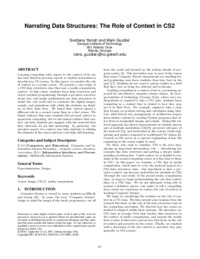Narrating data structuresthe role of context in CS2
Svetlana Yarosh, Mark Guzdial
Publikationsdatum:
Zu finden in: ICER 2007 (Seite 87 bis 98), 2007
|
 |
 Diese Seite wurde seit 5 Jahren inhaltlich nicht mehr aktualisiert.
Unter Umständen ist sie nicht mehr aktuell.
Diese Seite wurde seit 5 Jahren inhaltlich nicht mehr aktualisiert.
Unter Umständen ist sie nicht mehr aktuell.
 Zusammenfassungen
Zusammenfassungen

Learning computing with respect to the context of its use has been linked in previous reports to student motivation in introductory CS courses. In this report, we consider the role of context in a second course. We present a case study of a CS2 data structures class that uses a media computation context. In this course, students learn data structures and object-oriented programming through a pervasive narrative about how real media professionals use data structures to model the real world and to construct the digital images, sounds, and animations with which the students are familiar in their daily lives. We found that context played a different role in a second course than in a first course. We found evidence that some students did not need context to appreciate computing, but we also found evidence that context can help students get engaged with the material that they otherwise do not find interesting. In particular, the narrative aspect of a context may help students in relating the elements of the course and may even help with learning.
 Dieses Konferenz-Paper erwähnt ...
Dieses Konferenz-Paper erwähnt ...
 Dieses Konferenz-Paper erwähnt vermutlich nicht ...
Dieses Konferenz-Paper erwähnt vermutlich nicht ... 
 Nicht erwähnte Begriffe | Informatik-Didaktik, Informatikunterricht in der Schule, Universität |
 Tagcloud
Tagcloud
 Zitationsgraph (Beta-Test mit vis.js)
Zitationsgraph (Beta-Test mit vis.js)
 1 Erwähnungen
1 Erwähnungen 
- ICER 2013 - International Computing Education Research Conference, ICER '13, La Jolla, CA, USA, August 12-14, 2013 (Beth Simon, Alison Clear, Quintin I. Cutts) (2013)
 Anderswo finden
Anderswo finden
 Volltext dieses Dokuments
Volltext dieses Dokuments
 |  Narrating data structures: Fulltext at the ACM Digital Library ( Narrating data structures: Fulltext at the ACM Digital Library ( : :  , 450 kByte; , 450 kByte;  : :  Link unterbrochen? Letzte Überprüfung: 2020-11-28 Letzte erfolgreiche Überprüfung: 2020-06-28) Link unterbrochen? Letzte Überprüfung: 2020-11-28 Letzte erfolgreiche Überprüfung: 2020-06-28) |
 Anderswo suchen
Anderswo suchen 
 Beat und dieses Konferenz-Paper
Beat und dieses Konferenz-Paper
Beat hat Dieses Konferenz-Paper während seiner Zeit am Institut für Medien und Schule (IMS) ins Biblionetz aufgenommen. Beat besitzt kein physisches, aber ein digitales Exemplar. Eine digitale Version ist auf dem Internet verfügbar (s.o.). Aufgrund der wenigen Einträge im Biblionetz scheint er es nicht wirklich gelesen zu haben. Es gibt bisher auch nur wenige Objekte im Biblionetz, die dieses Werk zitieren.









 Hochschule
Hochschule
 Biblionetz-History
Biblionetz-History